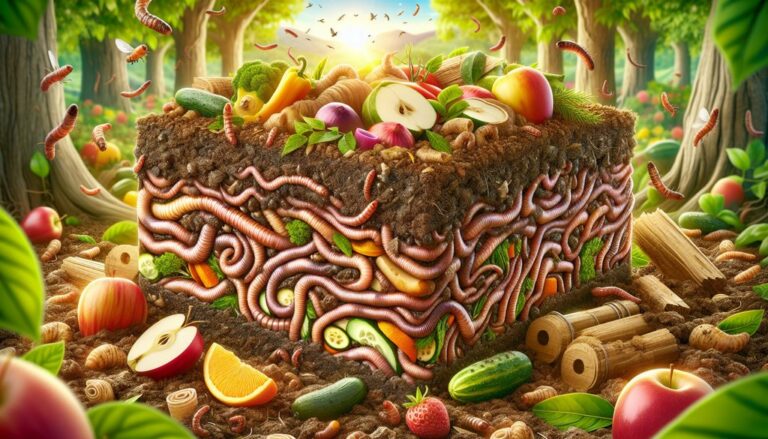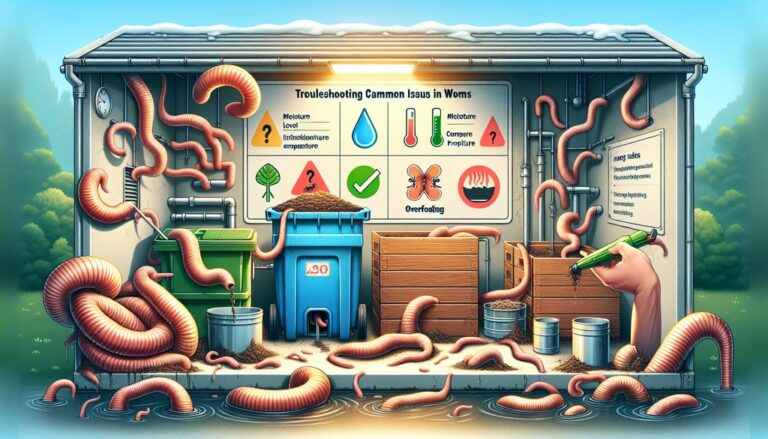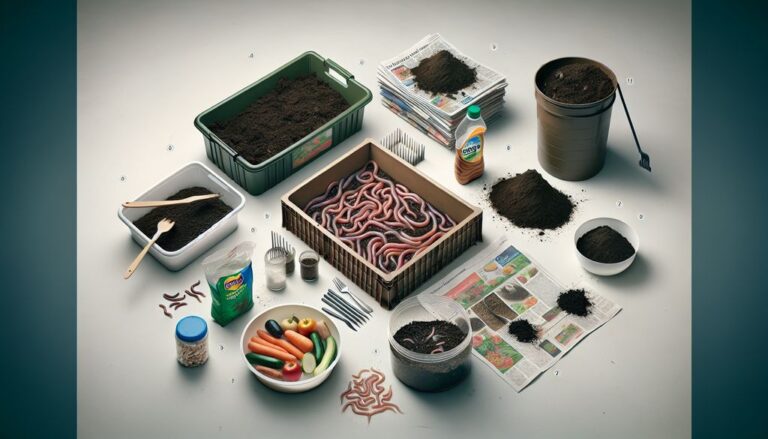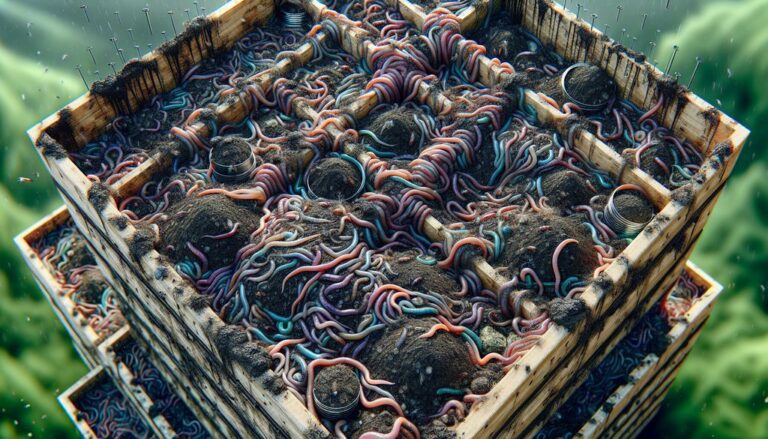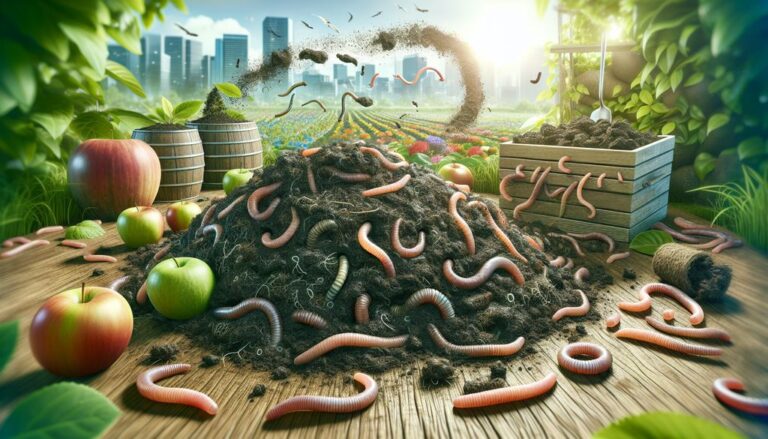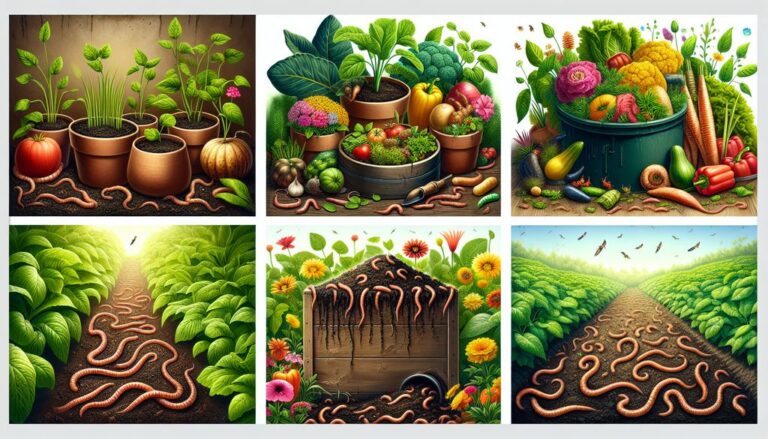Worm composting, also known as vermicomposting, is a sustainable and eco-friendly way to recycle organic waste. It involves using worms to break down food scraps and other organic materials into nutrient-rich compost. Despite its many benefits, there are several myths surrounding worm composting that need to be debunked. In this article, we will explore the top 10 myths about worm composting and provide evidence-based explanations to debunk them.
Key Takeaways
- Worm composting does not attract pests when managed properly.
- Properly maintained worm bins do not emit bad odors.
- Worm composting can be low-maintenance and easily integrated into daily routines.
- Various species of worms can effectively compost organic materials.
- Basic knowledge and simple guidelines are sufficient to start and maintain worm composting.
1. Worm Composting Attracts Pests
One common misconception about worm composting is that it will attract unwanted pests. This is largely untrue if the bin is properly managed. Maintaining a balanced compost bin by not overfeeding and ensuring adequate bedding will discourage pests. Here are some simple steps to prevent pest attraction:
- Regularly bury food scraps to avoid attracting flies.
- Keep the bin’s moisture level in check to prevent odors that attract pests.
- Use a bin with a tight-fitting lid to keep rodents out.
Worm composting systems, when well-maintained, do not attract pests any more than other forms of composting.
It’s important to understand that pests are attracted to readily available food sources and odors, not the worms themselves. By following the above steps, you can enjoy the benefits of worm composting without the worry of attracting pests.
2. Worm Bins Emit Bad Odors
One common misconception about worm composting is the fear of unpleasant smells. Properly maintained worm bins do not emit bad odors. In fact, a healthy worm bin should smell like fresh earth. If a bin starts to smell, it’s often a sign of overfeeding, inadequate aeration, or excess moisture.
- Overfeeding: Worms can only process a certain amount of food waste at a time. Excess food can rot and produce odors.
- Aeration: Without enough air, the bin can become anaerobic, leading to a foul smell.
- Moisture: Too much moisture can create a swampy environment, which is also a cause of bad smells.
By managing these factors, you can ensure your worm bin remains odor-free. Regularly check the balance of food scraps, bedding, and moisture, and avoid adding materials that are not recommended for worm composting, such as dairy, meats, and oily foods.
Remember, worm composting is a natural process that, when balanced, should integrate seamlessly into your home or garden without any offensive odors.
3. Worm Composting is Labor-Intensive
One common misconception about worm composting is that it requires a lot of work. In reality, worm composting is quite low-maintenance once the system is established. Here’s what you need to know:
- Setting up your worm bin is the most labor-intensive part. You’ll need to create a comfortable environment for the worms, which includes bedding, moisture, and initial food scraps.
- Maintenance involves feeding the worms regularly with kitchen scraps, checking moisture levels, and occasionally fluffing the bedding to ensure proper aeration.
- Harvesting the compost, which is typically done every few months, can be as simple as moving the finished compost to one side of the bin and adding fresh bedding to the other side. The worms will migrate to the new bedding, leaving the compost ready for use.
The beauty of worm composting is that the worms do most of the work for you. They continuously break down food scraps and turn them into nutrient-rich compost, with minimal intervention required.
Remember, worms are efficient creatures that thrive in the environment you provide. With a little initial effort to set up your bin and a routine check-up, your composting system can run smoothly with very little work on your part.
4. Only Specific Worm Species Can Compost
It’s a common misconception that only certain elite species of worms can be used for composting. In reality, while some worms are indeed better suited for the task, a variety of species can be effective composters. The most popular worms for composting are red wigglers (Eisenia fetida) and European nightcrawlers (Eisenia hortensis).
However, these are not the only options. Here’s a brief list of worms that can also be used for composting:
- African nightcrawlers (Eudrilus eugeniae)
- Blue worms (Perionyx excavatus)
- Indian blue worms (Perionyx sansibaricus)
Each species has its own unique benefits and can thrive under different conditions. For instance, African nightcrawlers perform well in warmer climates, while red wigglers are adaptable to a variety of environments.
It’s important to choose the right type of worm based on your local climate and the specific needs of your composting setup. With a little research, you can find the perfect worm to help you turn your organic waste into nutrient-rich compost.
5. Worm Composting Requires Expert Knowledge
One common misconception is that worm composting, or vermicomposting, is a complex process that requires expert knowledge. This is simply not true. Vermicomposting can be started and maintained with basic understanding and a few simple steps:
- Select the right type of worms: Red wigglers (Eisenia fetida) are the most common and efficient for composting.
- Prepare the bin: Ensure proper ventilation and drainage. A dark, cozy environment is ideal for worms.
- Feed your worms: Kitchen scraps like fruit and vegetable peels, coffee grounds, and eggshells are perfect. Avoid meat, dairy, and oily foods.
- Maintain the bin: Keep it in a cool, shaded area and ensure the bedding remains moist.
With regular observation and minimal adjustments, anyone can manage a successful worm composting system. It’s a learning process, but one that is accessible to all, not just the experts.
Resources are widely available, from online forums to local workshops, making it easy for beginners to get started and troubleshoot any issues. The key is to begin with the basics and learn as you go, allowing the worms to do most of the work for you.
6. Worm Bins Take Up Too Much Space
One common misconception about worm composting is that it requires a large amount of space. This is simply not true. Worm bins are incredibly versatile and can be adapted to fit almost any space, whether you live in a small apartment or have a sprawling backyard.
- Small-scale bins: Ideal for indoor use, can be kept under the sink, on a balcony, or in a pantry.
- Medium-scale bins: Suitable for larger households or small gardens, can be placed in a garage or shed.
- Large-scale systems: Designed for extensive composting needs, such as for community gardens or businesses.
Worm composting systems are scalable and can be customized to suit your space and waste output needs.
Remember, the size of the bin should correspond to the amount of organic waste you produce. A small bin can process the scraps from a single person or a couple, while larger families or food-related businesses might opt for a bigger system. The key is to start with what you need and scale up as necessary.
7. Worm Composting is Expensive
One common misconception about worm composting is that it requires a significant financial investment. This is simply not true. Starting a worm composting system can be quite affordable, especially when considering the long-term benefits of producing your own nutrient-rich compost.
- Initial Setup Costs: A basic worm bin can be made from a variety of materials, including repurposed containers or simple wooden crates. The most important cost is the worms themselves, which can be a one-time purchase.
- Maintenance Costs: Worm composting requires minimal upkeep. Kitchen scraps and paper waste, which are free and readily available, serve as food for the worms.
- Long-term Savings: By creating your own compost, you reduce the need to purchase commercial fertilizers, leading to savings over time.
While there may be some upfront costs associated with setting up a worm composting system, the ongoing expenses are negligible compared to the benefits of producing your own compost.
8. Worms Escape from Composting Bins Easily
One common misconception about worm composting is that worms will frequently escape from their bins. This is largely untrue if the bin is properly maintained. Worms generally prefer the environment inside the compost bin, where food and moisture are abundant. If worms are escaping, it’s often a sign that the bin conditions need to be adjusted.
- Ensure the bin has adequate bedding material like shredded newspaper or cardboard.
- Keep the moisture level consistent; it should be like a wrung-out sponge.
- Feed worms a balanced diet; avoid overfeeding.
- Provide proper ventilation but not too much light, as worms prefer darkness.
By creating an environment that meets the worms’ needs, you significantly reduce the chances of them trying to leave the bin. Remember, a happy worm is a composting worm!
It’s also worth noting that worms are not adept climbers on smooth surfaces, so bins with slick sides can help prevent escapes. Regularly checking and maintaining your bin will ensure that your worms stay put and continue to compost effectively.
9. Composting Worms Transmit Diseases
One common concern about worm composting is the fear that the worms could be carriers of diseases. This is largely a myth. Composting worms, like the red wiggler, are not known to transmit diseases to humans. In fact, the composting process can actually reduce pathogens present in the waste material due to the microbial activity and the heat generated during decomposition.
The conditions inside a well-maintained worm bin are not conducive to the survival of human pathogens. Worm composting, when done correctly, is a safe and hygienic way to recycle organic waste.
It’s important to note that the health of the worm bin ecosystem is key to preventing any potential issues. Here are some best practices to ensure a healthy worm bin:
- Maintain proper moisture levels; the bin should feel like a wrung-out sponge.
- Keep a balanced mix of ‘greens’ (nitrogen-rich materials) and ‘browns’ (carbon-rich materials).
- Regularly turn or aerate the compost to provide oxygen and prevent anaerobic conditions.
- Avoid adding meat, dairy, or oily foods that can attract pests and cause rot.
By following these simple guidelines, you can enjoy the benefits of worm composting without the worry of disease transmission.
10. Worm Composting Doesn’t Work in Cold Climates
The belief that worm composting is ineffective in cold climates is a common misconception. Worms can indeed thrive and compost effectively in colder regions with the right setup and management. Here’s how:
- Insulation: Protecting your worm bin from extreme cold is crucial. Insulation can be as simple as placing the bin in a garage or shed, or adding insulating materials like straw or foam around it.
- Location: Keeping the bin in a spot that avoids direct exposure to the elements can prevent freezing.
- Worm species: Certain worms, like the red wiggler (Eisenia fetida), are more tolerant of lower temperatures.
By maintaining a bin temperature between 40-80 degrees Fahrenheit (4-27 degrees Celsius), worms can continue to process organic waste throughout the year.
Remember, the key to successful worm composting in colder climates is to prevent the bin from freezing. While worms slow down as temperatures drop, they can still remain active enough to compost. With a bit of extra care during the winter months, your worm composting efforts can be just as fruitful as in warmer climates.
Conclusion
In conclusion, worm composting is a sustainable and effective method of recycling organic waste. By debunking these top 10 myths, we hope to encourage more people to consider worm composting as a viable solution for reducing environmental impact and promoting healthy soil. Remember, worms are nature’s recyclers, and with the right knowledge, anyone can successfully implement worm composting at home or in a community setting. Let’s work together to embrace this eco-friendly practice and make a positive impact on the environment.
Frequently Asked Questions
How do I prevent pests in my worm composting bin?
To prevent pests, make sure the composting bin is properly maintained and has a balanced mixture of organic materials. Avoid adding meat, dairy, and oily foods, and keep the bin covered to prevent access for pests.
How can I reduce bad odors from my worm composting bin?
To reduce bad odors, ensure that the composting bin is well-aerated and has a proper balance of green and brown materials. Avoid overfeeding the worms and maintain the right moisture level in the bin.
Is worm composting time-consuming?
Worm composting requires minimal time and effort. Once the bin is set up, it only needs occasional maintenance such as adding food scraps and checking the moisture level.
Can any type of worms be used for composting?
Yes, various species of worms can be used for composting, but red worms (Eisenia fetida) and red wigglers (Lumbricus rubellus) are the most commonly used for their efficient composting abilities.
Do I need special knowledge to start worm composting?
No, worm composting is easy to start and requires basic knowledge of maintaining a composting bin. There are plenty of resources and guides available to help beginners get started.
Can worm composting be done in a small space?
Yes, worm composting can be done in small spaces using compact worm bins or vermicomposting systems designed for limited space.

